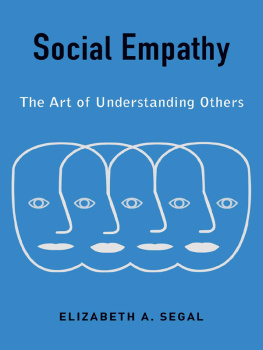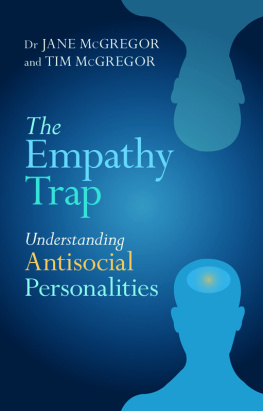Columbia University Press
Publishers Since 1893
New York Chichester, West Sussex
cup.columbia.edu
Copyright 2017 Columbia University Press
All rights reserved
E-ISBN 978-0-231-54388-0
ISBN 978-0-231-18190-7 (cloth: alk. paper)
ISBN 978-0-231-18191-4 (paperback: alk. paper)
Cataloging-in-Publication Data is on file at the Library of Congress.
A Columbia University Press E-book.
CUP would be pleased to hear about your reading experience with this e-book at .
Cover design: Jordan Wannemacher
Mention empathy to people and they are likely to agree that empathy is vital to all human interactions. The importance of empathy in society cannot be understated; it is the glue that holds communities together and the skill that promotes being in tune with others, coordinating activities, and caring for those in need (de Waal, 2009, p. x). Social scientists, using research and direct practice experience, almost uniformly regard empathy as what furthers our survival and enhances our social life. Empathy and all of its components are foundational to who we are and why we succeed as a species (Zaki & Ochsner, 2013, p. 225).
Interest in empathy has increased dramatically in recent years. Empathy is part of our human biological and social make-up. It involves a complex interaction of physiological responses and cognitive processing, which has been neurologically identified over the past ten years (Coplan & Goldie, 2011; Decety, 2012, 2015). Social service professionals from numerous disciplines have developed a deep interest in empathy. For example, there are more than two thousand training studies outlining ways for practitioners to enhance empathy (Butters, 2010). Empathy has also drawn broader public interest. Recent popular books about empathy have targeted general audiences, highlighting the positive social impact of empathy (Pinker, 2011; Rifkin, 2009; Szalavitz & Perry, 2010). Talk of empathy has reached the highest levels of our government. In his commencement address at Morehouse College in 2013, President Barack Obama encouraged the graduates to pursue empathy as the way to succeed in the world, crediting his own success to a sense of empathy and connection to others (Obama, 2013).
In spite of this attention to empathy, ask people to define empathy or explain it in detail and there is likely to be a great deal of variation and very little specificity, even among those who cite empathy as a critical skill in their professions. This thing called empathy tends to be broadly interpreted and applied. The number of competing conceptualizations circulating the literature has created a serious problem with the study of empathy by making it difficult to keep track of which process or mental state the term is being used to refer to in any given discussion (Coplan, 2011, p. 4). If we are to arrive at a clear explanation and an acceptable definition of empathy, we should examine our current understanding of empathy and how it came to be.
In its most basic form, empathy is feeling and understanding the emotions and experiences of others. Although seemingly straightforward, this definition is full of complications. Feeling something and understanding what it means are different experiences. When you add the activity of trying to identify and understand the feeling of someone else to your own feelings and understandings in a given situation, matters become more complex, and then they become even more so if you do not know the other person or are very different from that person. The eminent social psychologist C. Daniel Batson (2011) identified eight phenomena that have been considered to express or enact empathy. They are presented in box 1.1.
In spite of the many and various definitions and conceptualizations of empathy we have, Batson (2011) found that what all have in common is that they describe a process in which one person can come to know the internal state of another and can be motivated to respond with sensitive care (p. 11). He suggests that the best we can do is to acknowledge and understand these phenomena, clearly identify how we are defining empathy, and then be consistent in how we apply the term. However, given that there are inconsistencies even within the same profession or in similar contexts, attempting to assess and to measure empathy is especially problematic. This book was written to address these challenges. See box 1.2 for a brief synopsis of them.
As noted in box 1.2, the multiplicity of definitions for empathy makes conducting research and comparing findings very difficult. Coplan (2011) argues for a more concise definition to be shared so that we can better analyze and evaluate empathy-related research. She posits that based on recent psychological and neuroscientific research, there are three features that distinguish empathy from other emotional or mental processes: affective matching , other-oriented perspective-taking , and self-other differentiation . These concepts will be developed in more detail later in this chapter. Briefly, they include mirroring emotions between an observer and the observed other (affective matching); placing oneself in another persons situation while staying focused on the others experiences rather than imagining how we might experience that situation (other-oriented perspective-taking); and clarity that we can share anothers experiences in a connecting way, still maintain our separate identity, and not substitute our understanding of the experience for that of the other (self-other differentiation). Coplan (2011) argues that only when all three of these features are present do we have empathy.
BOX 1.1 CONCEPTS USED TO DEFINE OR REFER TO EMPATHY
- Knowing another persons thoughts and feelings, also referred to as cognitive empathy or empathic accuracy .
- Matching the physical responses of an observed other on a neural level, also referred to as mirroring , imitation , or motor mimicry .
- Feeling the same emotions that another person feels, sometimes referred to as shared physiology ; this is considered to be sympathy by some.
- Mentally projecting oneself into the situation of another, which involves theory of mind and is sometimes referred to as aesthetic empathy .
- Imagining how another is thinking and feeling, sometimes referred to as psychological empathy , projection , or perspective-taking .
- Putting oneself in the others place, sometimes referred to as cognitive empathy , role-taking , or simulation and often considered to be akin to walking in someone elses shoes.
- Experiencing distress from observing another persons suffering, sometimes referred to as empathic distress or personal distress ; this can also involve a process of emotional contagion .
- Having feelings for another person who is suffering, sometimes referred to as empathic concern ; often this is equated with feelings of pity, compassion, or sympathy.
(adapted from Batson, 2011)
BOX 1.2 A BRIEF NOTE ABOUT MEASURING EMPATHY
The breadth of definitions of empathy begs the question: How do we measure empathy? If there are so many conceptualizations, then assessing whether people have empathy and whether empathic abilities can change is very difficult. Critiques of empathy measures that have developed over the past thirty years center on the ambiguity and multiplicity of the term empathy (Eisenberg & Lennon, 1983; Gerdes, Segal, & Lietz, 2010; Pedersen, 2009; Wisp, 1986). The inconsistency in definitions leads to imprecise measurements and raises questions about their validity. In addition, the variety of definitions and operationalizations of empathy means that making useful comparisons between different research findings is difficult and even meaningless at times (Coplan, 2011; Pithers, 1999). The major assessment tools used to measure empathy that are found in the literature are reviewed in more detail in .


 Columbia University Press New York
Columbia University Press New York










